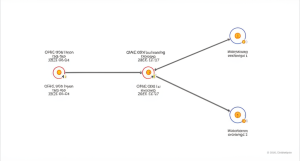
The Fight Against Fraud: MEXC’s Q2 2025 Progress and the Path Forward
The Growing Threat of Syndicate Fraud in Cryptocurrency
The cryptocurrency landscape has witnessed remarkable growth, but this expansion has also attracted malicious actors seeking to exploit vulnerabilities within the ecosystem. Syndicate fraud, in particular, has emerged as a significant threat, with organized groups employing sophisticated tactics to defraud users and undermine trust in digital asset platforms. These syndicates operate with a level of coordination and technical prowess that makes them particularly challenging to combat. Their activities range from account takeovers and fake transactions to market manipulation and wash trading, all of which contribute to a climate of uncertainty and distrust.
The impact of syndicate fraud extends beyond individual users. It erodes confidence in cryptocurrency exchanges, discourages institutional investment, and creates regulatory challenges for the industry as a whole. As the value of digital assets continues to rise, so too does the incentive for criminal syndicates to target the crypto space. This makes the efforts of exchanges like MEXC to combat fraud not just a matter of protecting their users, but also a critical step in safeguarding the future of the cryptocurrency ecosystem.
MEXC’s Q2 2025 Risk Control Summary: A Closer Look
MEXC’s Q2 2025 Risk Control Summary provides a detailed snapshot of the exchange’s efforts to mitigate syndicate fraud and enhance security for its users. The report highlights a 12% decrease in fraud attempts compared to the previous quarter, a statistic that underscores the effectiveness of MEXC’s risk control measures. However, the numbers behind this headline figure reveal an even more complex picture of the challenges facing the exchange and the broader crypto industry.
During Q2 2025, MEXC’s systems detected and blocked over 70,621 fraud attempts, a staggering figure that illustrates the scale of the threat. These attempts were linked to more than 8,501 distinct criminal syndicates, demonstrating the fragmented and dynamic nature of fraudulent activity in the cryptocurrency space. The identification of such a large number of syndicates suggests that fraudsters are constantly adapting their tactics and forming new groups to evade detection and continue their illicit activities.
The decline in fraud attempts can be attributed, in part, to MEXC’s strengthened risk control infrastructure. This includes upgrades to fraud detection systems, improved KYC and AML procedures, and enhanced security protocols. These measures have likely made it more difficult for syndicates to operate on the platform, forcing them to either abandon their efforts or adapt their strategies to bypass MEXC’s defenses.
The Multifaceted Approach to Combating Syndicate Fraud
The reduction in syndicate fraud attempts on MEXC is the result of a multifaceted approach that combines technological advancements, user education, and industry collaboration. Each of these components plays a crucial role in creating a more secure trading environment and protecting users from fraudulent activities.
Technological Advancements
Technological innovation is at the forefront of MEXC’s efforts to combat syndicate fraud. The exchange has invested heavily in upgrading its fraud detection systems, leveraging advanced algorithms and machine learning techniques to identify suspicious activity in real time. These systems can analyze vast amounts of data to detect patterns and anomalies that may indicate fraudulent behavior, allowing MEXC to block fraud attempts before they can cause harm.
In addition to fraud detection, MEXC has enhanced its user authentication processes, implementing multi-factor authentication (MFA) and other security measures to prevent unauthorized access to user accounts. Real-time monitoring capabilities have also been improved, enabling the exchange to respond quickly to emerging threats and mitigate potential risks.
User Education and Awareness
While technological solutions are essential, user education and awareness are equally important in the fight against syndicate fraud. MEXC has launched various initiatives to educate its users about common fraud tactics, such as phishing, malware, and social engineering attacks. By empowering users with the knowledge and tools to protect themselves, MEXC can create a more secure trading environment and reduce the likelihood of successful fraud attempts.
These educational efforts include tutorials, webinars, and informational articles that cover topics such as recognizing phishing emails, securing accounts with strong passwords, and identifying suspicious activity. By fostering a culture of security awareness, MEXC can help its users become more vigilant and proactive in protecting their assets.
Industry Collaboration and Law Enforcement Partnerships
Collaboration with other industry stakeholders and law enforcement agencies is another critical aspect of MEXC’s strategy to combat syndicate fraud. By sharing information and best practices with other cryptocurrency exchanges, blockchain analytics firms, and cybersecurity companies, MEXC can contribute to a more robust defense against fraud. This collaborative approach enables the industry to stay ahead of emerging threats and develop more effective solutions to protect users.
Partnerships with law enforcement agencies are also essential in identifying and prosecuting criminal syndicates involved in cryptocurrency fraud. By working closely with authorities, MEXC can help dismantle fraudulent operations and bring perpetrators to justice, sending a strong message to other would-be fraudsters.
The Broader Implications of MEXC’s Success
The reduction in syndicate fraud attempts on MEXC has significant implications for the exchange, its users, and the broader cryptocurrency industry. A safer trading environment fosters greater trust among users, encouraging them to actively participate in the platform and engage in trading activities. This increased user confidence can lead to higher trading volumes and revenue for MEXC, as well as a more vibrant and dynamic marketplace for digital assets.
Moreover, a reputation for security and reliability can differentiate MEXC from its competitors, attracting new users and solidifying its position in the market. By demonstrating its commitment to protecting users and maintaining a secure trading environment, MEXC can set a high standard for the industry and inspire other exchanges to adopt similar measures.
The decline in fraud attempts also has important implications for regulatory compliance. As governments around the world seek to regulate the cryptocurrency industry, exchanges that prioritize security and implement robust risk control measures are better positioned to meet evolving regulatory requirements. By proactively addressing fraud and other security concerns, MEXC can help shape the regulatory landscape and contribute to the long-term stability and growth of the cryptocurrency ecosystem.
The Evolving Threat Landscape and the Future of Crypto Security
While MEXC’s progress in reducing syndicate fraud is encouraging, the fight against cryptocurrency fraud is far from over. Criminal syndicates are constantly evolving their tactics, employing new technologies and strategies to evade detection and continue their illicit activities. As the threat landscape continues to evolve, exchanges must remain vigilant and proactive in their security efforts, embracing new technologies and fostering greater collaboration to protect users and maintain trust in the digital asset ecosystem.
Emerging Threats in Cryptocurrency Security
One of the most concerning emerging threats in cryptocurrency security is the use of deepfakes and synthetic identity fraud. AI-generated deepfakes can be used to impersonate users and bypass KYC procedures, creating significant challenges for exchanges seeking to verify the identity of their customers. Similarly, synthetic identity fraud involves the creation of fake identities using a combination of real and fabricated information, making it difficult for exchanges to detect and prevent fraudulent activity.
Decentralized finance (DeFi) platforms are also increasingly targeted by hackers seeking to exploit vulnerabilities in smart contracts. These exploits can result in significant financial losses for users and undermine confidence in the DeFi ecosystem. As DeFi continues to grow in popularity, the need for robust security measures to protect against these threats becomes even more critical.
Ransomware attacks are another growing concern for cryptocurrency exchanges and users. Hackers encrypt data and demand payment in cryptocurrency for its release, creating a lucrative incentive for criminal syndicates to target the crypto space. The use of cryptocurrency in ransomware attacks has made it more difficult for law enforcement agencies to track and recover stolen funds, further exacerbating the problem.
The Role of AI in Crypto Security
Artificial intelligence (AI) is playing an increasingly important role in combating cryptocurrency fraud. AI-powered systems can analyze vast amounts of data in real time to detect suspicious patterns and anomalies that might indicate fraudulent activity. By leveraging machine learning algorithms, exchanges like MEXC can identify fraudulent transactions, accounts, and activities with greater speed and accuracy than traditional methods.
AI can also be used to assess the risk associated with individual transactions and users, allowing exchanges to prioritize security measures accordingly. This risk scoring approach enables MEXC to allocate its resources more effectively and focus its efforts on the most high-risk areas of the platform.
In addition to fraud detection and risk scoring, AI can automate and improve the accuracy of KYC and AML processes. By analyzing vast amounts of data and identifying patterns that may indicate fraudulent activity, AI can help exchanges comply with regulatory requirements and reduce the likelihood of successful fraud attempts.
The Path Forward: Embracing Innovation and Collaboration
As the threat landscape continues to evolve, exchanges like MEXC must remain at the forefront of innovation and collaboration in the fight against cryptocurrency fraud. This means embracing new technologies, such as AI and machine learning, to enhance fraud detection and prevention capabilities. It also means fostering greater collaboration with other industry stakeholders, law enforcement agencies, and regulatory bodies to create a more robust defense against fraud.
By working together, the cryptocurrency industry can develop more effective solutions to protect users and maintain trust in the digital asset ecosystem. This collaborative approach is essential for the long-term success and sustainability of the crypto space, as it enables the industry to stay ahead of emerging threats and adapt to the ever-changing threat landscape.
Conclusion: A Call to Action for the Crypto Community
MEXC’s reported 12% decline in syndicate fraud attempts during Q2 2025 is a testament to the power of innovation, collaboration, and proactive security measures. However, it is also a reminder that the fight against cryptocurrency fraud is an ongoing battle that requires the collective efforts of the entire crypto community. As criminal syndicates continue to evolve their tactics, exchanges, users, and industry stakeholders must remain vigilant and committed to safeguarding the integrity of the digital asset ecosystem.
The path forward lies in embracing new technologies, fostering greater collaboration, and prioritizing user education and awareness. By working together, the crypto community can create a more secure and trustworthy environment for all participants, ensuring the long-term success and sustainability of the cryptocurrency industry. The time to act is now, and the stakes have never been higher. The future of crypto security depends on our collective efforts to combat fraud and protect the interests of users worldwide.





